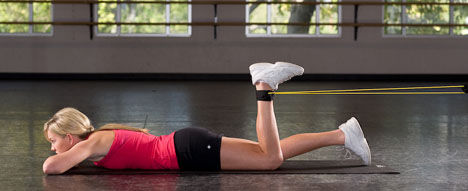
By Karen Merrill, M.S.
Recovering from a knee injury can be a frustrating undertaking for clients and trainers alike. It is important to have a thorough understanding of why the primary injury occurred so that those factors can be addressed during the rehabilitation and post-rehab process. Once this information has been established, the following six essential steps for safely returning to strength training can put you or your clients back on the road to better health and fitness following a knee injury.
Step 1: Establish a Simple Stretching Routine
Prior to starting a strength-training routine, implement a simple stretching routine to properly warm up the legs and to ensure that balance is maintained between strength and flexibility gains for all of all of the lower-extremity muscles. It is important to take the time and energy to stretch properly.
Step 2: Strengthen the Muscles Surrounding the Knee
Strengthening the muscles that surround the knee is vitally important following a knee injury. These muscles decrease the stresses experienced by the knee joint itself during daily activities and in sports participation. Individuals who have stronger muscles surrounding the knee normally have fewer problems with the joint, because the muscles provide support and stability. When the muscles around the knee are weak, they expose the joint to more stress and therefore predispose the knee to a higher risk of injury.
The muscles that surround the knee joint include the quadriceps, hamstring and calf muscles. Following a knee injury, these muscles become weakened due to lack of use and the required rest during the healing process.
Step 3: Strengthen the Muscles That Support the Hip Joint
Strengthening the muscles that support the hip joint to ensure stability up the kinetic chain from the knee is also crucial. A comprehensive lower-extremity strength-training program for the knee should focus on the hip abductors, hip flexors and gluteal muscles to ensure that the larger joint above the knee is stable and not contributing to any increase in knee-joint stress. Exercises focusing on these areas include: squats, single-leg squats, lateral step-ups, lateral raises, lunges and quadruped hip extensions.
Step 4: Develop Lower-extremity Muscular Endurance
Develop muscular endurance of the lower-extremity muscles, which is essential for maintaining performance and remaining injury-free. If a muscle is strong but lacks endurance, it will not be able to perform for any significant amount of time and will quickly become fatigued. Experiencing fatigue during the early stage of muscle recruitment predisposes the muscles to a higher risk of injury. Low-impact cardiovascular exercise, such as the stationary bicycle, elliptical trainer and aquatic fitness, is generally considered the best way to increase muscular endurance.
Exercises for Increasing Muscular Endurance (Step 4)
Elliptical trainer, stationary bicycle, recumbent bike, aquatic-based exercise
Step 5: Focus on Improving Balance
Proprioception is the body’s ability to transmit a sense of position, analyze that information and react (consciously or unconsciously) to the stimulation with the proper movement. Dangers due to loss of balance while conducting these types of exercises require close supervision, especially in an injury-recovering environment. Working on improving a client’s proprioception abilities includes focusing on balance, coordination and agility. It is important to implement exercises that incorporate proprioceptive development so that clients can develop the balance skills necessary to maintain stability; sharpen their agility skills so they can quickly change direction when necessary; and fine-tune coordination skills so they can perform physical activities accurately and consistently.
Proprioception exercises reduce the risk of injury by teaching the body to react appropriately to sudden changes in the environment. Start the training routine with simple exercises that emphasize static balance and increase the complexity as proprioception improves. There are many fun exercise equipment options such as stability balls, balance boards, BOSU Balance Trainers, wobble boards and Bongo Boards, which can be used alone or with conventional equipment like resistance bands and weighted balls. When these tools are used appropriately, they can help clients master their static and dynamic balance challenges. To increase the complexity of the training program, be sure to change the variables used such as the surface, distance, duration, and weight of the objects used to distract the client as appropriate over time.
Step 6: Enhance Coordination and Agility
Advanced proprioception activities are designed to improve agility and coordination skills. These activities include pivoting, twisting, cutting and jumping, as well as sport-specific activities, such as lateral movements, running and backward movements. The first step in dynamic balance training is to master proper form, not speed. To make activities more difficult as the client progresses, increase the speed and/or distance. These exercises are also designed to facilitate sport-specific requirements for each client. For example, jumping can take place either on the floor or on appropriately sized plyometric boxes. Start agility- and coordination-training exercises with pivoting, twisting and cutting activities (always done on both feet) so that the client develops a strong and stable foundation before adding jumping exercises. If needed, progress to single-leg jumps once a strong base has been established. These advanced exercises, which may include ladders, cones, hurdles and reactive drills, should only be introduced once a solid strength and stability foundation has been firmly established following the knee injury.

Karen Merrill, M.S., is a licensed and certified athletic trainer, massage therapist and ACE-certified Advanced Health & Fitness Specialist and Lifestyle & Weight Management Coach. Named the 2004 ACE Personal Trainer of the Year, Merrill has more than 17 years of experience working with a diverse clientele, and enjoys helping individuals achieve their short- and long-term athletic and wellness goals in a safe and effective environment.